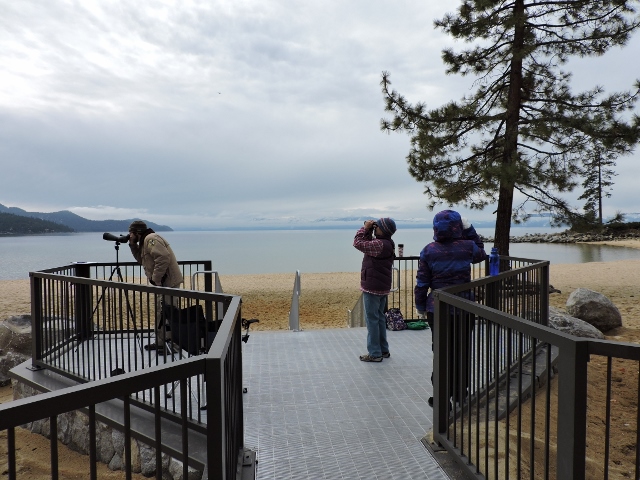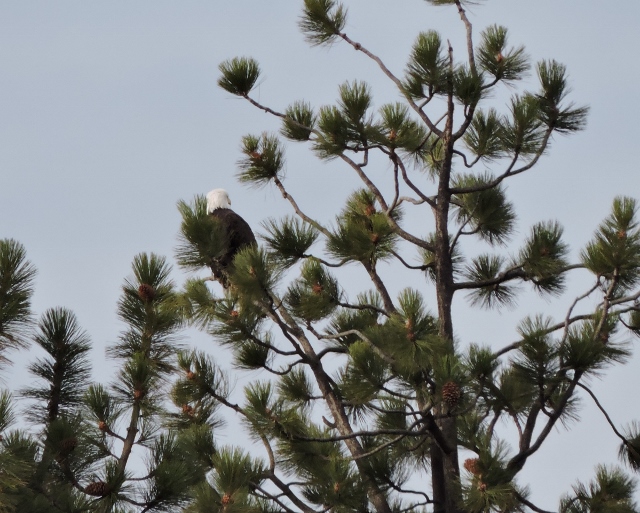saveourplanetearth.com
Call us: (775) 831-1331
Bald Eagle Survey
Each January, thousands of volunteers across the nation count eagles as part of a nationwide Midwinter Bald Eagle Survey, currently coordinated by the U.S. Army Corps of Engineers.
The National Wildlife Federation introduced the survey in 1979. Objectives of the survey are to establish an index of the wintering bald eagle population in the lower 48 states, to determine eagle distribution around the nation, and to perhaps identify previously unrecognized areas of winter habitat.
The Lake Tahoe area survey is coordinated by the Tahoe Institute for Natural Science (TINS) and took place on January 10, from 9 a.m. to noon. I was fortunate enough to be able to participate this year at the Sand Harbor station, where we spotted an adult bald eagle about 30 minutes into the observation period.
I spent the morning with Judy, Jody, Darilyn and Mark Enders, a Nevada Department of Wildlife biologist. We were scanning the skies and the tree line when suddenly Jody exclaimed, “There’s an eagle right there!” It wasn’t very far away and was certainly watching us before we spotted him. He sat high up in the tree for about 15 minutes while we watched him, sharing our observation with some lucky passersby; then he flew north, which we duly noted on our observation sheet.
We didn’t spot another eagle that morning but we were able to observe what was most likely a male Williamson’s sapsucker busily pecking at the bark of a tree, feeding on sap and insects. A common merganser floated by on the lake in front of us as he searched for fish, and Mark spotted a red-tailed hawk, far up on the hill.
As we scanned our surroundings, searching for more treasures, we chatted about everything from minnows to sugar pines, sharing the bond of the love of nature. It was a chilly day, but nevertheless, immensely satisfying to be a part of an important research project.
Not all the observation stations were able to report seeing an eagle but at least two areas reported seeing five individuals. A good place to scout for bald eagles is at the Upper Truckee Marsh in South Shore, an area where waterfowl congregate in the wintertime, providing feeding opportunities for the eagles. Five bald eagles were spotted here.
Volunteers at the observation station at Lake Forest Beach in Tahoe City also were able to spot five bald eagles.
Final results are not yet available, however, generally at least 15 bald eagles are counted lake-wide during the survey. Last year, 21 eagles were counted and the survey’s local organizer, Will Richardson of TINS thinks the count will be in the high teens, if not over 20, again this year.
Here are some eagle-watching tips presented by the National Wildlife Federation:
When you head out to see eagles, keep in mind that human presence can stress the birds and cause them to waste precious energy that they need to survive. To avoid being disruptive, follow these basic tips:
• Stay in or near your vehicle at roadside viewing areas
Stay in or near your vehicle at roadside viewing areas
• Avoid making loud noises, such as yelling, slamming car doors and honking horns
Avoid making loud noises, such as yelling, slamming car doors and honking horns
• Use binoculars or a spotting scope to view the birds from a comfortable distance
Use binoculars or a spotting scope to view the birds from a comfortable distance
• Never attempt to make an eagle fly
Never attempt to make an eagle fly
The Midwinter Bald Eagle Survey follows the Christmas Bird Count which is conducted in mid-December. This count takes place in a 7.5 mile radius circle located at Cove East, the wetlands in the Upper Truckee Marsh near the Tahoe Keys.
This year’s count took place on December 15 when a total of 80 species were recorded, with an additional nine reported throughout the count week. Some surprising results emerged: five Pacific loons were seen, a high count for the area in December. This bird generally over-winters on the ocean, mainly on the Pacific coast or other large bodies of water.
Another ocean bird making an appearance were a pair of surf scoters, a large sea duck normally found along the northern coasts of the United States during the winter.
If you missed these birding opportunities, TINS is sponsoring for the first time the Tahoe Big Year (TBY), an informal competition where participants can record species they see in a calendar year, 2015, within the TBY boundaries, which include the Tahoe basin and Truckee.
TINS will be conducting monthly TBY birding tours for TINS members. Learn about becoming a supporting member of TINS and participating in the Tahoe Big Year at tahoebigyear.org.
Volunteers scanning the trees during the Annual Bald Eagle Survey.
Photo courtesy of Mark Enders
Nevada Department of Wildlife Biologist
An adult bald eagle is spotted.
Photo courtesy of Mark Enders
Nevada Department of Wildlife Biologist




